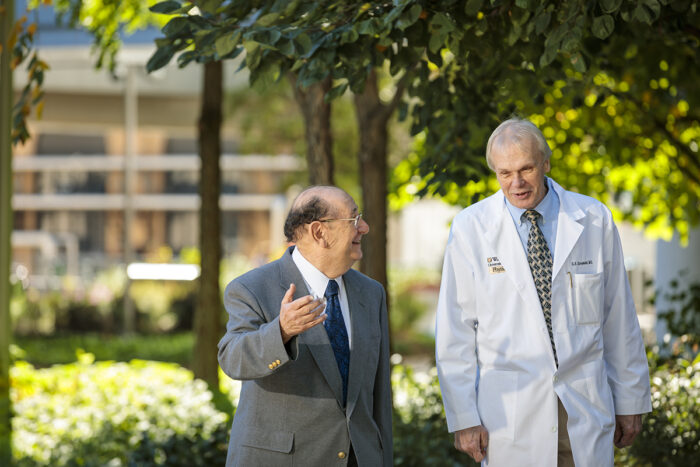New antidepressants on horizon
Neuroactive steroid drugs result from Taylor Family Institute, pharma collaboration
 Matt Miller
Matt MillerDouglas F. Covey, PhD (left), Charles F. Zorumski, MD, (right) and their colleagues at the Taylor Family Institute for Innovative Psychiatric Research have pioneered the use of neurosteroid drugs to treat psychiatric illness.
More than 14 million Americans suffer from clinical depression, yet one in three doesn’t experience relief from approved antidepressant drugs. A new treatment approach involving drugs called neuroactive steroids is on the horizon, however.
Neuroactive steroids occur naturally in the brain and help regulate and modulate the activity of brain cells, but similar molecules also can be synthesized in the laboratory. They target different receptors in the brain than currently available antidepressants and appear to relieve symptoms more quickly than traditional antidepressants. The strategy of using neuroactive steroid molecules to treat depression is being pursued at Washington University School of Medicine in St. Louis, where its Taylor Family Institute for Innovative Psychiatric Research has been focused on developing more effective psychiatric drugs.
Meanwhile, Sage Therapeutics, has developed a neuroactive steroid called SAGE-217 that was shown to be effective in a recent clinical trial. Studying 89 patients — 45 of whom were randomly chosen to receive SAGE-217, while the other 44 received an inactive placebo — researchers found that the investigational drug reduced symptoms of depression in less than two weeks. The results were published recently in The New England Journal of Medicine.
Charles F. Zorumski, MD, the Samuel B. Guze Professor and head of the Department of Psychiatry, directs the Taylor Family Institute and also is a member of Sage Therapeutics’ Scientific Advisory Board. He was one of the authors on the recent publication. He said the speed at which SAGE-217 is heading toward clinical use is remarkable. Another neuroactive steroid drug developed by Sage already has been approved for clinical use in the United States. The intravenous drug Zulresso (brexanalone) was approved by the Food and Drug Administration in March to treat women suffering from serious postpartum depression. Zorumski described the ongoing development of neuroactive steroids to treat depression and possibly other psychiatric illnesses.
The neuroactive steroid drug for postpartum depression was the first new antidepressant to come to market in years. What most excites you about this new class of drugs?
First, the investigational drug SAGE-217 is a proof of concept that you can develop an oral neuroactive steroid drug to treat men and women with major depression. That’s a big deal. Secondly, the drug is given once daily, with a dose of 30 mg per day, so patients don’t have to take multiple pills each day, which can be the case with other antidepressants. And third, we were excited to see how quickly the drug alleviated symptoms. Patients were doing better in the first few days on the drug. After a week on the drug, they were clearly distinguished from those taking a placebo, and then they continued to improve over 14 days. When the drug was stopped after two weeks, patients maintained the benefit from the drug for almost another 30 days, which was as long as the study lasted. The fact the drug was effective in a two-week trial, that it worked so quickly and that its effects apparently persist is unusual in psychiatry. That’s different from any of the other oral drugs now available for depression.
Where was this drug developed?
This particular drug is a Sage Therapeutics compound. Doug Covey, the Andrew C. and Barbara B. Taylor Distinguished Professor of Psychiatry, who has developed more than 700 neuroactive steroid compounds in his lab was involved in the initial aspects of the research at Sage. The university subsequently licensed a library of compounds to Sage, and although SAGE-217 is not one of the hundreds of compounds discovered here, there is a joint Washington University-Sage compound, SAGE-689 that is progressing toward clinical trials now as it’s being developed by Sage Thereapeutics. That drug arose from a collaboration between Sage and the university.
How do these neuroactive steroid drugs relieve depression?
We believe they interact with GABA receptors in the brain. GABA is the major inhibitory neurotransmitter in the brains of all mammals, so an agent that augments GABA can modulate brain activity.
Can you explain the relationship between Sage and the Taylor Family Institute, and how that’s helping move these drugs into clinical trials?
Our work at Washington University opened eyes to the potential uses of neuroactive steroids and how the chemical structure of these steroids influences their activity. Initially, nobody thought these naturally occurring molecules would make good drugs because many were vulnerable to being broken down in the body so that they never would make it to the brain. When our early neuroactive steroid research looked promising, we proposed the strategy to various pharmaceutical companies. Sage was formed in 2010, with Steven Paul, MD, and Doug Covey, PhD, as co-founders of the company. I have served on the company’s scientific advisory board and have been involved in discussions about mechanisms of action and which clinical trials should be designed. And as early data first came in on the latest drug, SAGE-217, it became clear that it could be effective in men and women with depression and that we probably should study it further in patients with treatment-resistant depression. That’s our plan here at the Taylor Family Institute: to evaluate neuroactive steroids in patients whose depression has not been relieved by other drugs because that’s where we could see the greatest impact.






